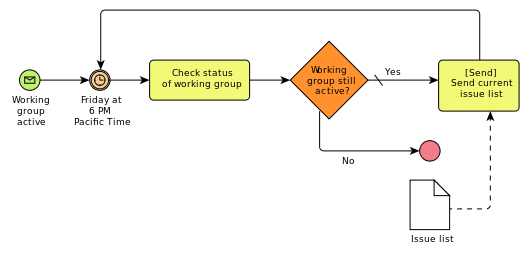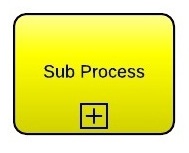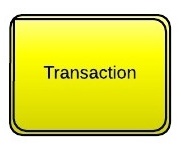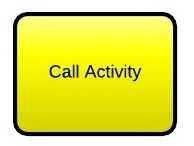What is Business Process Modeling and Notation (BPMN) – Tallyfy
Process maps can be very confusing – without a single, unified procedure for documenting processes, understanding them can be hard for anyone that’s not directly involved with the mapping. Business Process Modeling and Notation (BPMN) is one of most-used business process modeling techniques, and it helps make process maps easier to understand for any relevant party (employee, management, consultants) through standardized symbols.
Mục Lục
What is Business Process Modeling and Notation (BPMN)
Business process modeling and notation is a flowchart method of graphing a business process. It’s done exactly the same way as you’d create a flowchart process map, the only difference is that BPMN comes with its own symbols and elements.
As we’ve already mentioned, this helps make process maps easier to understand for any relevant party.
As with process flowcharts, BPMN is essential for business process management (BPM), one of the most popular process improvement methodologies.
A bit about Tallyfy
Are you looking to automate tasks between co-workers or clients? You’ve found the right app for that! With Tallyfy – you can automate tasks and business processes – within minutes.
Let’s resume the rest of this article!

Image Source: wikipedia
Want to reap the benefits of BPMN, without having to train your entire company on how to use it? Certain
Want to reap the benefits of BPMN, without having to train your entire company on how to use it? Certain workflow systems come with intuitive process mapping capabilities, making the maps easy to understand for just about anyone.
What is Tallyfy?
Tallyfy helps you document and automate tasks between co-workers and clients
Click here to learn about Tallyfy
BPMN Purpose & Benefits
While process modeling isn’t anything particularly new, it tends to have its flaws. The concept can be very vague, as there is no standardized way to do it. Everyone can create a process map. Making it easy to understand for everyone, however, isn’t easy.
In a large organization, this can be a major problem. You’d want different people to look at the process map and actually understand it. This includes the management, field employees, process improvement experts, etc. Even if your organization has it’s own methodology and symbolism for modeling, you’d still have a hard time getting outside experts, clients, or investors to understand.
So, as a means of creating a universal standard for process mapping, business process modeling and notation (BPMN) was developed. It allows for a standardized way to map your processes, in a way that every stakeholder can understand what each symbol means.
The methodology was developed by the Business Process Management Initiative (BPMI), and was known initially as “business process modeling notation.” In 2011, with the release of BPMN v2.0, the name was changed to “Business Process Model and Notation.”
BPMN 2.0 Elements and Symbols
Since BPMN aims at standardization, only specific graphical representations are used for different activities. Once you have mastered this graphic “language,” you can grasp what’s going on in the worfklow diagram at a glance without the need for further explanations.
The four different elements or objects used for BPMN are:
Flows: events, activities, and gateways
Connections: sequence Flow, message flow, and association
Swimlanes: pool or lane
Artifacts: data object, group, annotation
Here’s how each works…
Flows
Events
The BPMN model begins and ends with events, and there will be several intermediate events in the diagram too. An event is something that happens. It is not a task or activity. Events are represented by circles. An ordinary circle is the starting point. A circle with a double border indicates an intermediate event, and a bold circle represents an endpoint.

Within the circle, an icon shows what happened. For example, the classic envelope icon indicates a message. But these events also have different nuances. Thus, you may receive a message, or you could be sending a message. These two nuances are captured in the terms “catching” and “throwing.”
The different types of circles we’ve just discussed indicate throwing and catching too. When an event starts a process, it will always be a “catch.” The final step will always be “throw” and the intermediate events are either Throw” or “catch.”
Activities
A task or activity carried out by either an individual or software. Activities are depicted as rectangles with rounded corners.

Some activities are single tasks that stand alone, but others are compound activities consisting of several sub-processes. Again, the visual language adapts in attempt to represent this clearly.0
Compound activities are tasks that consist of several sub-processes. Using BPMN software, you can show or hide these sub-processes. When you view the diagram, you will now that there are sub-processes in an activity thanks to a plus icon at the bottom of the rectangle. When you expand the icon by clicking on it, a diagram showing all the sub-processes, flows, connections, and artifacts show up.

The term “transaction” indicates activities in which every single step is so closely related that failing in one step would undo all the work contained within the compound activity. To indicate a transaction, the visual language uses a double border.

Finally, we have call activities. These are activities in which a global task is used again. Here, the rectangle has a bold border.

Gateway
A gateway is a conditional element and is indicated by diamonds. There are several different types of such events:
- There are exclusive gateways that move workflows from one route to another. They indicate that there is only one option.
- There are event-based gateways that depend on something (other than the task) that happens.
- There are parallel ones in which two paths are side by side and don’t depend on an event.
- There are inclusive gateways, complex gateways, and parallel event based gateways. Each of these also has its own

Connections
By now, you will not be surprised to know that there are several different kinds of flows and that each of these is represented differently.
- A solid line with an arrowhead shows how flows happen in sequence.
- Message flows show lines of communication, and they are represented by a dashed line with a throw and catch symbol at the beginning and end.
- Then, there are association flows. They show how an artifact or text relates to a flow. Flow direction can be indicated by an arrow, but not when the flow is associated with a message.

Swim Lanes
Sometimes, different departments and even different organizations need to work together to achieve something. The pool consists of the functions or organizations who participate, and each of these has their own swim lane. Inside each lane, there are flows, objects, and artifacts.

Artifacts
Artifacts show that there is information that must be referenced outside of the BPMN diagram. Each type of additional information has its own icon.
- A document icon shows that data is needed or that data is about to be produced.
- A rounded edge rectangle with a dotted border shows that activities form a group.
- Annotations revert to regular text to explain certain elements.
The most important part is this – what does Tallyfy offer than BPMN does not?
Read more about it here















![Toni Kroos là ai? [ sự thật về tiểu sử đầy đủ Toni Kroos ]](https://evbn.org/wp-content/uploads/New-Project-6635-1671934592.jpg)


